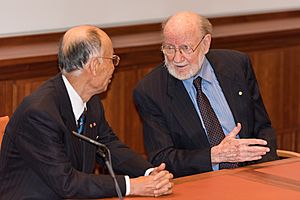William C. Campbell (scientist) facts for kids
Quick facts for kids
William C. Campbell
|
|
|---|---|

Campbell in 2015
|
|
| Born | 28 June 1930 Ramelton, County Donegal, Ireland
|
| Citizenship | Ireland United States (since 1964) |
| Alma mater | Trinity College, Dublin University of Wisconsin-Madison (PhD) |
| Known for | Discovery of avermectin |
| Awards | Membership of NAS (2002) Nobel Prize in Physiology or Medicine (2015) FRS (2020) |
| Scientific career | |
| Fields | Parasitology |
| Institutions | Merck & Co. Drew University |
| Thesis | Fascioloides magna (trematoda) with special reference to the adult in relation to disease (1957) |
William Cecil Campbell is an Irish-American scientist born on June 28, 1930. He is a microbiologist, meaning he studies very tiny living things. He is famous for his work in finding new ways to treat infections. These infections are caused by tiny creatures called roundworms.
For his important discoveries, he won the 2015 Nobel Prize in Physiology or Medicine. He helped find a group of medicines called avermectins. These medicines are very good at treating serious diseases. They help with illnesses like River blindness and Lymphatic filariasis. These diseases affect both animals and people around the world. Campbell worked at a company called Merck & Co. for many years. Later, he became a special researcher at Drew University.
Contents
William Campbell's Life Story

William Campbell was born in 1930 in a place called Ramelton, in Ireland. He was the third son in his family. He went to Trinity College, Dublin to study Zoology. He graduated in 1952 with top honors.
After that, he went to the University of Wisconsin–Madison in the United States. He studied there on a special scholarship. In 1957, he earned his PhD degree. His research was about a parasite called the liver fluke. This parasite affects animals like sheep.
Discoveries at Merck
From 1957 to 1990, Campbell worked at the Merck Institute for Therapeutic Research. He became a US citizen in 1964. While at Merck, he made many important discoveries. One of them was a medicine called thiabendazole. This medicine is a fungicide, which means it fights fungus. It was used to treat potato blight, a plant disease that caused a lot of trouble in Ireland's history. Thiabendazole is also used to treat a human illness called trichinosis.
Campbell is most well-known for his work on diseases caused by parasites. A Japanese microbiologist named Satoshi Ōmura found many types of bacteria in soil. These bacteria belonged to a group called Streptomyces. Campbell led a team at Merck to study Ōmura's bacteria. They wanted to see if these bacteria could help treat parasites in animals.
From one specific type of soil bacteria, Streptomyces avermitilis, Campbell's team found a new substance. After changing it a bit, they named it ivermectin. This medicine is also known as Mectizan.
Fighting Parasitic Diseases
In 1978, Campbell realized that ivermectin could treat worms in horses. He thought it might also help with similar worms that affect people. In 1981, Merck started testing the medicine on people. They had successful tests in Senegal and France for a disease called river blindness.
When people take ivermectin by mouth, it helps stop the parasitic worm that causes the illness. The medicine makes the worm unable to move or have babies. Merck also studied how to use this medicine to treat another disease called elephantiasis. The research by Satoshi Ōmura, William Campbell, and their teams created a whole new group of medicines. These medicines are very important for treating parasitic diseases.
Donating Medicine to the World
In 1987, Merck made a big decision. They decided to give away Ivermectin (Mectizan) for free to developing countries. Campbell played a key role in making this happen. Merck worked with the World Health Organization to create a special program. Their goal was to get rid of river blindness completely.
By 2001, about 25 million people were getting treated each year. This happened in 33 countries in Africa, Latin America, and the Middle East. By 2013, independent groups confirmed that river blindness was gone in Colombia, Ecuador, and Mexico. This shows how successful the program has been.
Campbell once said, "The biggest challenge for science is to think globally. We need to think simply and act on it. It would be terrible to ignore the diseases in developing countries. One part of the world affects another part. We have a duty to help each other. We also need to take care of our own needs. It has to be both."
Teaching and Later Life
From 1990 until he retired in 2010, Campbell was a research fellow at Drew University. He helped college students with their research. He also taught classes about parasitology, the study of parasites. He has written about the history of studying parasites during trips to Antarctica.
In 2002, Campbell became a member of the United States National Academy of Sciences. In 2015, he and Satoshi Ōmura shared half of the Nobel Prize in Physiology or Medicine. They won for their research on treatments for roundworm parasites. These treatments use medicines made from avermectin. Campbell is one of several Irish people to win a Nobel Prize.
Personal Life
William C. Campbell is married to Mary Mastin Campbell. He enjoys writing poetry and painting. For fun, he likes to play table tennis and go kayaking.
Awards and Honors
- 2002: Became a member of the National Academy of Sciences
- 2008: Received the ASP Distinguished Service Award from the American Society of Parasitologists
- 2015: Won the Nobel Prize in Physiology or Medicine for finding avermectin. He shared this award with Satoshi Ōmura and Tu Youyou.
- 2020: Became a Fellow of the Royal Society
- 2021: Received the St Patrick's Day Science Medal from Science Foundation Ireland
See also
 In Spanish: William C. Campbell (científico) para niños
In Spanish: William C. Campbell (científico) para niños

